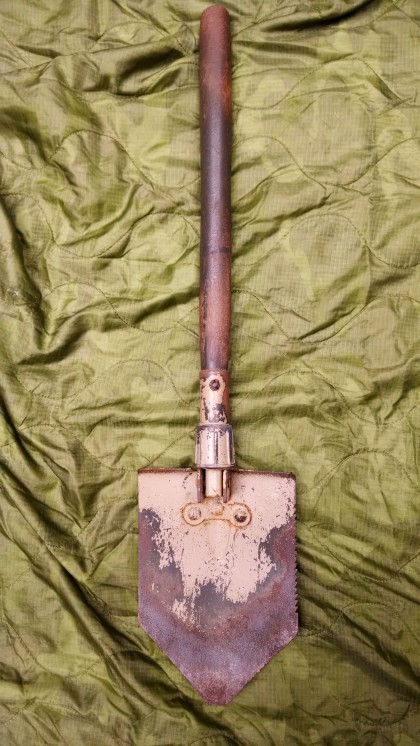
I never would have guessed that this old shovel would be one of my most useful tools for counting horseshoe crab eggs on Delaware Bay beaches.
I’ve had it since I was a 10-year old aspiring outdoorsman. It was part of a collection of various paramilitary gear I had back then — things such as a mess kit, army jacket, canteen, and survival knife.
This little entrenching shovel has proven to be the perfect tool for digging small cube-shaped holes on the beach in order to count the number of horseshoe crab egg clusters under the sand, eight inches down. A full size shovel keeps the digger at a distance from what is being dug. My shovel, on the other hand, lets you dig with a close-up view, allowing the digger to carefully examine the sand for egg clusters.
We’ve been digging about 400 of these little trenches on eight different beaches once per week. All to look at patterns of horseshoe crab activity on restored and unrestored beaches.
The 8″ deep samples are taken to characterize egg distribution and abundance down where the crabs want their eggs: safe under the sand in clusters, developing into crab larvae over the course of several weeks.
We take samples at the surface too. This is where the crabs don’t want them: scattered at or near the surface and available for shorebirds to eat.
Fortunately for red knots and and other shorebirds, sand disturbance by other crabs and the action of wind and waves brings considerable numbers of eggs to the surface.
We count these surface eggs by taking about 50 ziploc bags full of sand from each beach once a week during the month of May.
We bring the bags back to the “lab” and count eggs one by one, carefully sorting eggs from sand.
By taking both shallow and deep samples, we can characterize food availability for birds and the reproductive success of the horseshoe crabs.
We are making these measurements on beaches that were restored, one that we plan to restore, and a few that are in good shape, not needing restoration at all.
By comparing these different beaches we can gauge the success of beach restoration.
Although I had my one trusty shovel, I wanted a second for a teammate to use. So I hopped online and bought what I thought was a shovel identical to mine. When it arrived, it was indeed nearly identical, except that a few key parts were now made of plastic. As a result, the shovel was not very good at doing the one thing it was designed to do: dig. The plastic collar designed to keep the folding shovel in a digging position wouldn’t stay tight so the shovel blade flopped all over the place.
I went back online and discovered that entrenching shovels are popular among survivalists and zombie hunters. Finally I came across a model that got great reviews, the cold steel non-folding shovel. I ordered one immediately.
The cold steel is a great product, very sturdily made and the steel is high quality and rust resistant. The paint job is also high quality and chip resistant. But I found the handle to be a little to thick in circumference and the shovel was overall too short. The blade itself was almost flat. A little curve would have made it a more practical digger.
Where the shovel excels, as many reviewers state, is as a weapon. The shovel came with all edges machete-sharp. Bottom line: though they call it a shovel, cold steel is a better weapon than shovel. I do not recommend online shovel shopping.
In the end, it was hard to beat my 30 year old WWII knock off entrenching shovel with all-metal construction.